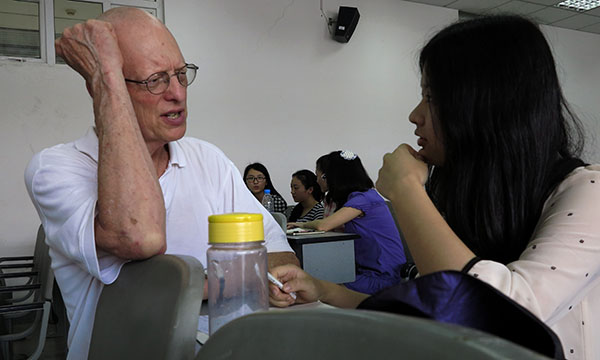Our intrepid traveler is two weeks into a month of lecturing at conferences, newspaper workshops and universities in Shanghai, Chongqing, Hefei and Zhengzhou, China. This follows last summer’s Fulbright to Beijing, where he taught at three universities, and where at one workshop, he was introduced as “Mr. Joke.” Herein follows Mr. Joke’s reprise.

The boy in the Make Love Not War T-shirt has a question.
And he’s not the only one.
During this morning’s lecture on journalism ethics in the U.S., I challenged the class to take notes (which they had not been doing) and to be prepared to turn in written questions that my lecture had raised.
Turns out they were paying attention after all.
How does a reporter handle the temptation to fabricate?
What do you do when an advertiser pressures you to give him or her some special coverage in the paper?
In your obligation to pursue the truth, and you anger a source with a negative story, don’t you put your family in harm’s way?
What are the difference between our countries relative to business and corporate privacy laws?
These tough questions demanded good answers, and I gave it my best shot.
What I loved about his morning’s class was this: the typical Chinese college classroom is nothing like most American college classrooms.
First of all, there is no AC, so the temperature today was so hot it was stupefying. Kids sat there looking stoned, fanning their faces with their notepads. I knew it would take something special to make today’s lesson get through.
Secondly, in the typical Chinese college classroom, there is no flexibility in the seating arrangement. It’s a formal stage-and-auditorium setting.
Chairs are all bolted down in rows, where the students sit like groundlings, and the professor sits like royalty behind a raised desk where he or she usually stays to deliver the lecture. The students sit silently while the teacher lectures. Snore.
The typical teaching model appears to be “the sage on the stage” as opposed to my favorite Socratic teaching method of “the guide by the side.”
So in today’s class, I attempted to break the mold. After all, I didn’t come 9,000 miles just to hear my jaws flap. I wanted these kids to engage!
First I ran the idea past Prof Li for his blessing. Thanks to his enthusiastic and receptive response, we put our plan into action.
After 45 minutes of Powerpoint (which is enough to send anyone to the next dimension), we broke up into small teams of 4-6 kids for group discussion, and then we let them chatter away for 10 minutes or so.
Then we took up the written questions. Put them in a hat, and drew random pieces of paper out of the hat, and read them aloud, and I answered them ,one by one.
So maybe it was a little like a TV game show — but in my experience, there’s nothing wrong with a little “stagecraft” when it comes to enlivening an otherwise boring lecture.
Did we succeed? I can only hope. At the end of the two hours my shirt was soaked through with sweat. Perhaps that is not a bad indicator. If nothing else, I get an ‘A’ for effort.

